PI-009: Seed Potato Tuber Inspection
Appendix 3: Soft Rot or Wet Breakdown
This page is part of the Guidance Document Repository (GDR).
Looking for related documents?
Search for related documents in the Guidance Document Repository
Causal agents:
Soft rot or wet breakdown is the general term used to describe tuber decomposition which may involve one or more fungi and/or bacterial agents. Soft rot may also be induced by mechanical or physical damage to the tuber such as by frost injury (1), freezing and chilling injuries (2) and bruising, and subsequent infection. Freezing injury most often shows a complete break down and watery rot of affected tubers. Tubers which have been exposed to freezing temperatures and allowed to warm up for 1 week to 10 days usually express classic symptoms of soft rot. Pathogenic agents of soft rot may include: Fusarium spp. (3), Blackleg or bacterial soft rot - Pectobacterium carotovorum subsp. carotovorum (4, 5), Early blight - Alternaria solani, Late Blight - Phytophthora infestans, Leak fungus - Pythium ultimum var. ultimum (6), among many others. Certain pathogens may be causative agents of both soft rot and dry rot.
Scoring:
In scoring soft rot or wet breakdown it is not always necessary to identify the specific pathogen affecting the tuber. Images below are not representative of all symptoms which may be encountered; any soft, mushy breakdown, soft leaking specimens or soft and watery tissue must be scored under the tolerance for soft rot or wet breakdown. Refer to Seeds Regulations Part II for tolerances. Quarantine pests may exhibit similar symptoms to soft rot, consult additional resources for information.
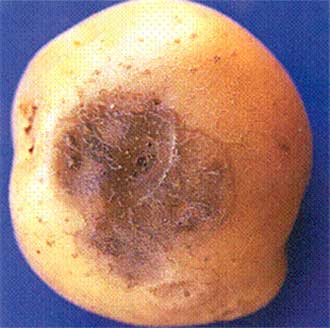
Description for 1
This is an image of a potato with wet spots caused by frost damage. There is a patch of dark brown sunken skin on the potato taking up 20% of its visible surface area which is a result of the frost damage.
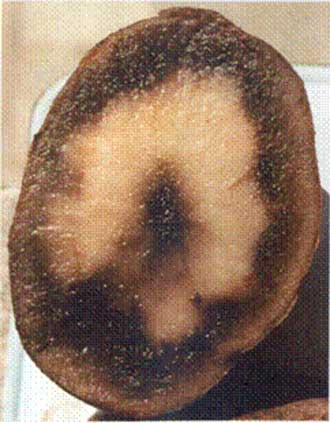
Description for 2
This is an image of a potato containing soft black tissue caused by freezing damage. It is cut in half down the middle so that the inside of the potato is visible. The potato's inside is nearly all black-brown with a concentration around the edges and a white area surrounding the black-brown core of the potato.
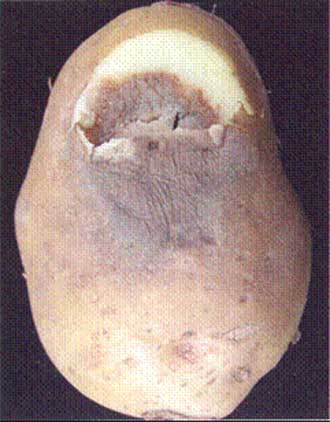
Description for 3
This is an image of a brown potato that shows a jelly-like consistency of tuber flesh as a result of a pathogenic agent of soft rot called Fusarium spp. The rot has caused a dark spot on the visible side of the potato to appear taking up approximately 20% of its surface area. A small portion of the potato is cut to show that the jelly-like consistency goes deeper than the surface.
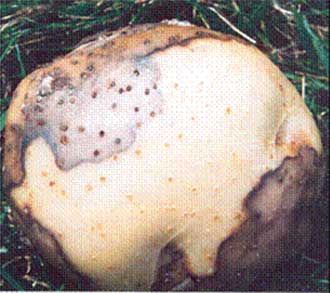
Description for 4
This image of brown potato shows the external tuber soft rot caused by a bacterial soft rot known as Pectobacterium carotovorum subsp. carotovorum. Half of the potato skin is unaffected and the remaining skin has blackened, receding edges. Small yellow spots cover the entire potato acting as its distinguishing feature with small white spots here and there.
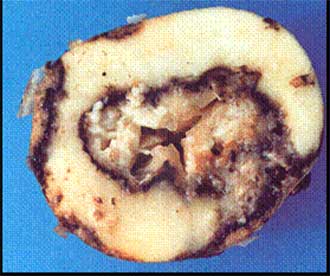
Description for 5
This is an internal image of a potato with tuber soft rot caused by a bacterium known as Pectobacterium carotovorum subsp. carotovorum. The potato is cut down the centre to reveal how the greater part of the potat's center has turned into a soft deformed mash outlined by blackened tissue.
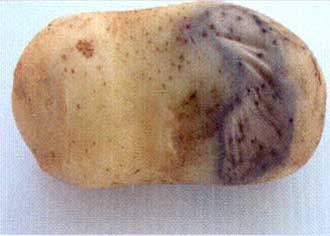
Description for 6
This is an image of a yellow potato with watery grey Leak fungus infection known as Pythium ultimum var. ultimum. The infection is present on one third of the visible side of the potato. The infected area is outlined in black and contains black spots over that area of skin which appears to be spreading.
- Date modified: